Antimicrobial Hydrophilic Membrane Formed by Incorporation of Polymeric Surfactant and Patchouli Oil
Abstract
:1. Introduction
2. Materials and Methods
2.1. Materials
2.2. Membrane Fabrication
2.3. Membrane Properties and Morphology
2.4. Anti-Bacterial Test
2.5. Permeation Test
2.6. Pesticide Removal Test
3. Results and Discussion
3.1. Membrane Structure
3.2. Chemical Compounds Indication
3.3. Hydrophilic Properties
3.4. Membrane Strength
3.5. Anti-Bacterial Performances
3.6. Ultrafiltration Performance
4. Conclusions
Author Contributions
Funding
Institutional Review Board Statement
Informed Consent Statement
Data Availability Statement
Acknowledgments
Conflicts of Interest
References
- Nagendran, A.; Arockiasamy, D.L.; Mohan, D. Cellulose Acetate and Polyetherimide Blend Ultrafiltration Membranes, I: Preparation, Characterization, and Application. Mater. Manuf. Process. 2008, 23, 311–319. [Google Scholar] [CrossRef]
- Algieri, C.; Epifanio, A.; Garofalo, A.; Aljlil, S.; Donato, L. Poly(vinyl alcohol)-based membranes for metoprolol transdermal delivery. Mater. Technol. 2021, 36, 430–439. [Google Scholar] [CrossRef]
- Zhang, R.; Liang, B.; Qu, T.; Cao, B.; Li, P. High-performance sulfosuccinic acid cross-linked PVA composite pervaporation membrane for desalination. Environ. Technol. 2017, 40, 312–320. [Google Scholar] [CrossRef] [PubMed]
- Kuzmyn, A.R.; Nguyen, A.T.; Teunissen, L.W.; Zuilhof, H.; Baggerman, J. Antifouling Polymer Brushes via Oxygen-Tolerant Surface-Initiated PET-RAFT. Langmuir 2020, 36, 4439–4446. [Google Scholar] [CrossRef] [Green Version]
- Gao, C.-M.; Chen, J.-C.; Liu, S.-H.; Xing, Y.-Q.; Ji, S.-F.; Chen, H.-Y.; Chen, J.-J.; Zou, P.; Cai, J.-N.; Fang, H. Development of hydrophilic PES membranes using F127 and HKUST-1 based on the RTIPS method: Mitigate the permeability-selectivity trade-off. Environ. Res. 2021, 196, 110964. [Google Scholar] [CrossRef] [PubMed]
- Ganjali, M.R.; Al-Naqshabandi, M.A.; Larijani, B.; Badiei, A.; Vatanpour, V.; Rajabi, H.R.; Rezania, H.; Paziresh, S.; Mahmodi, G.; Kim, S.-J.; et al. Improvement of dye and protein filtration efficiency using modified PES membrane with 2-mercaptoethanol capped zinc sulfide quantum dots. Chem. Eng. Res. Des. 2021, 168, 109–121. [Google Scholar] [CrossRef]
- Wahab, M.Y.; Muchtar, S.; Jeon, S.; Fang, L.; Rajabzadeh, S.; Takagi, R.; Arahman, N.; Mulyati, S.; Riza, M.; Matsuyama, H. Synergistic effects of organic and inorganic additives in preparation of composite poly(vinylidene fluoride) antifouling ultrafiltration membranes. J. Appl. Polym. Sci. 2019, 136, 1–10. [Google Scholar] [CrossRef]
- Salimi, P.; Aroujalian, A.; Iranshahi, D. Graft copolymerization of zwitterionic monomer on the polyethersulfone membrane surface by corona air plasma for separation of oily wastewater. Sep. Purif. Technol. 2021, 258, 117939. [Google Scholar] [CrossRef]
- Moradi, G.; Rahimi, M.; Zinadini, S. Antifouling nanofiltration membrane via tetrathioterephthalate coating on aniline oligomers-grafted polyethersulfone for efficient dye and heavy metal ion removal. J. Environ. Chem. Eng. 2021, 9, 104717. [Google Scholar] [CrossRef]
- Tran, N.; Le, A.; Ho, M.; Dang, N.; Thanh, H.H.T.; Truong, L.; Huynh, D.P.; Hiep, N.T. Polyurethane/polycaprolactone membrane grafted with conjugated linoleic acid for artificial vascular graft application. Sci. Technol. Adv. Mater. 2020, 21, 56–66. [Google Scholar] [CrossRef] [PubMed] [Green Version]
- Zhang, Y.; Wang, Z.; Lin, W.; Sun, H.; Wu, L.; Chen, S. A facile method for polyamide membrane modification by poly(sulfobetaine methacrylate) to improve fouling resistance. J. Membr. Sci. 2013, 446, 164–170. [Google Scholar] [CrossRef]
- Chiao, Y.-H.; Sengupta, A.; Chen, S.-T.; Hung, W.-S.; Lai, J.-Y.; Upadhyaya, L.; Qian, X.; Wickramasinghe, S.R. Novel thin-film composite forward osmosis membrane using polyethylenimine and its impact on membrane performance. Sep. Sci. Technol. 2020, 55, 590–600. [Google Scholar] [CrossRef]
- Ronen, A.; Lerman, S.; Ramon, G.; Dosoretz, C. Experimental characterization and numerical simulation of the anti-biofuling activity of nanosilver-modified feed spacers in membrane filtration. J. Membr. Sci. 2015, 475, 320–329. [Google Scholar] [CrossRef]
- Choi, W.; Shin, M.G.; Yoo, C.H.; Park, H.; Park, Y.-I.; Lee, J.S.; Lee, J.-H. Desalination membranes with ultralow biofouling via synergistic chemical and topological strategies. J. Membr. Sci. 2021, 626, 119212. [Google Scholar] [CrossRef]
- Orooji, Y.; Movahedi, A.; Liu, Z.; Asadnia, M.; Ghasali, E.; Ganjkhanlou, Y.; Razmjou, A.; Karimi-Maleh, H.; Kiadeh, N.T.H. Luminescent film: Biofouling investigation of tetraphenylethylene blended polyethersulfone ultrafiltration membrane. Chemosphere 2021, 267, 128871. [Google Scholar] [CrossRef] [PubMed]
- Rahimi, Z.; Zinatizadeh, A.; Zinadini, S. Preparation of high antibiofouling amino functionalized MWCNTs/PES nanocomposite ultrafiltration membrane for application in membrane bioreactor. J. Ind. Eng. Chem. 2015, 29, 366–374. [Google Scholar] [CrossRef]
- Fahrina, A.; Yusuf, M.; Muchtar, S.; Fitriani, F.; Mulyati, S.; Aprilia, S.; Rosnelly, C.M.; Bilad, M.R.; Ismail, A.F.; Takagi, R.; et al. Development of anti-microbial polyvinylidene fluoride (PVDF) membrane using bio-based ginger extract-silica nanoparticles (GE-SiNPs) for bovine serum albumin (BSA) filtration. J. Taiwan Inst. Chem. Eng. 2021, 125, 323–331. [Google Scholar] [CrossRef]
- Abdelhamid, A.E.; Khalil, A.M. Polymeric membranes based on cellulose acetate loaded with candle soot nanoparticles for water desalination. J. Macromol. Sci. Part A 2019, 56, 153–161. [Google Scholar] [CrossRef]
- Alkhouzaam, A.; Qiblawey, H. Synergetic effects of dodecylamine-functionalized graphene oxide nanoparticles on antifouling and antibacterial properties of polysulfone ultrafiltration membranes. J. Water Process. Eng. 2021, 42, 102120. [Google Scholar] [CrossRef]
- Kumar, R.S.; Arthanareeswaran, G. Nano-curcumin incorporated polyethersulfone membranes for enhanced anti-biofouling in treatment of sewage plant effluent. Mater. Sci. Eng. C 2019, 94, 258–269. [Google Scholar] [CrossRef]
- Soh, S.H.; Jain, A.; Lee, L.Y.; Jayaraman, S. Optimized extraction of patchouli essential oil from Pogostemon cablin Benth. with supercritical carbon dioxide. J. Appl. Res. Med. Aromat. Plants 2020, 19, 100272. [Google Scholar] [CrossRef]
- Arahman, N.; Mulyati, S.; Fahrina, A.; Muchtar, S.; Yusuf, M.; Takagi, R.; Matsuyama, H.; Nordin, N.A.H.; Bilad, M.R. Improving Water Permeability of Hydrophilic PVDF Membrane Prepared via Blending with Organic and Inorganic Additives for Humic Acid Separation. Molecules 2019, 24, 4099. [Google Scholar] [CrossRef] [PubMed] [Green Version]
- Rahman, N.A.; Sotani, T.; Matsuyama, H. Effect of the addition of the surfactant Tetronic 1307 on poly(ether sulfone) porous hollow-fiber membrane formation. J. Appl. Polym. Sci. 2008, 108, 3411–3418. [Google Scholar] [CrossRef]
- Liu, M.; Liu, S.-H.; Skov, A.L.; Xu, Z.-L. Estimation of phase separation temperatures for polyethersulfone/solvent/non-solvent systems in RTIPS and membrane properties. J. Membr. Sci. 2018, 556, 329–341. [Google Scholar] [CrossRef] [Green Version]
- Tan, X.; Rodrigue, D. A Review on Porous Polymeric Membrane Preparation. Part I: Production Techniques with Polysulfone and Poly (Vinylidene Fluoride). Polymers 2019, 11, 1160. [Google Scholar] [CrossRef] [Green Version]
- Arahman, N.; Mulyati, S.; Lubis, M.R.; Razi, F.; Takagi, R.; Matsuyama, H. Modification of polyethersulfone hollow fiber membrane with different polymeric additives. Membr. Water Treat. 2016, 7, 355–365. [Google Scholar] [CrossRef]
- Liu, Y.; Su, Y.; Zhao, X.; Li, Y.; Zhang, R.; Jiang, Z. Improved antifouling properties of polyethersulfone membrane by blending the amphiphilic surface modifier with crosslinked hydrophobic segments. J. Membr. Sci. 2015, 486, 195–206. [Google Scholar] [CrossRef]
- Sadrzadeh, M.; Bhattacharjee, S. Rational design of phase inversion membranes by tailoring thermodynamics and kinetics of casting solution using polymer additives. J. Membr. Sci. 2013, 441, 31–44. [Google Scholar] [CrossRef]
- Mavukkandy, M.O.; Bilad, M.R.; Kujawa, J.; Al-Gharabli, S.; Arafat, H. On the effect of fumed silica particles on the structure, properties and application of PVDF membranes. Sep. Purif. Technol. 2017, 187, 365–373. [Google Scholar] [CrossRef]
- Elcik, H.; Cakmakci, M.; Özkaya, B. Preparation and characterisation of novel polysulfone membranes modified with Pluronic F-127 for reducing microalgal fouling. Chem. Pap. 2017, 71, 1271–1290. [Google Scholar] [CrossRef]
- Fahmi, Z.; Mudasir, M.; Rohman, A. Attenuated Total Reflectance-FTIR Spectra Combined with Multivariate Calibration and Discrimination Analysis for Analysis of Patchouli Oil Adulteration. Indones. J. Chem. 2019, 20, 1–8. [Google Scholar] [CrossRef]
- Habibi, S.; Nematollahzadeh, A. Enhanced water flux through ultrafiltration polysulfone membrane via addition-removal of silica nano-particles: Synthesis and characterization. J. Appl. Polym. Sci. 2016, 133, 1–9. [Google Scholar] [CrossRef]
- Zhang, D.; Karkooti, A.; Liu, L.; Sadrzadeh, M.; Thundat, T.; Liu, Y.; Narain, R. Fabrication of antifouling and antibacterial polyethersulfone (PES)/cellulose nanocrystals (CNC) nanocomposite membranes. J. Membr. Sci. 2018, 549, 350–356. [Google Scholar] [CrossRef]
- Fahrina, A.; Arahman, N.; Mulyati, S.; Aprilia, S.; Nawi, N.I.M.; Aqsha, A.; Bilad, M.R.; Takagi, R.; Matsuyama, H. Development of Polyvinylidene Fluoride Membrane by Incorporating Bio-Based Ginger Extract as Additive. Polymers 2020, 12, 2003. [Google Scholar] [CrossRef] [PubMed]
- Syafiuddin, A.; Boopathy, R.; Mehmood, M.A. Bioresource Technology Reports Recent advances on bacterial quorum quenching as an effective strategy to control biofouling in membrane bioreactors. Bioresour. Technol. Rep. 2021, 15, 100745. [Google Scholar] [CrossRef]
- Jung, Y.-J.; Kiso, Y.; Othman, R.A.A.B.; Ikeda, A.; Nishimura, K.; Min, K.-S.; Kumano, A.; Ariji, A. Rejection properties of aromatic pesticides with a hollow-fiber NF membrane. Desalination 2005, 180, 63–71. [Google Scholar] [CrossRef]
- Mukherjee, A.; Mehta, R.; Saha, S.; Bhattacharya, A.; Biswas, P.K.; Kole, R.K. Removal of multiple pesticide residues from water by low-pressure thin-film composite membrane. Appl. Water Sci. 2020, 10, 1–8. [Google Scholar] [CrossRef]

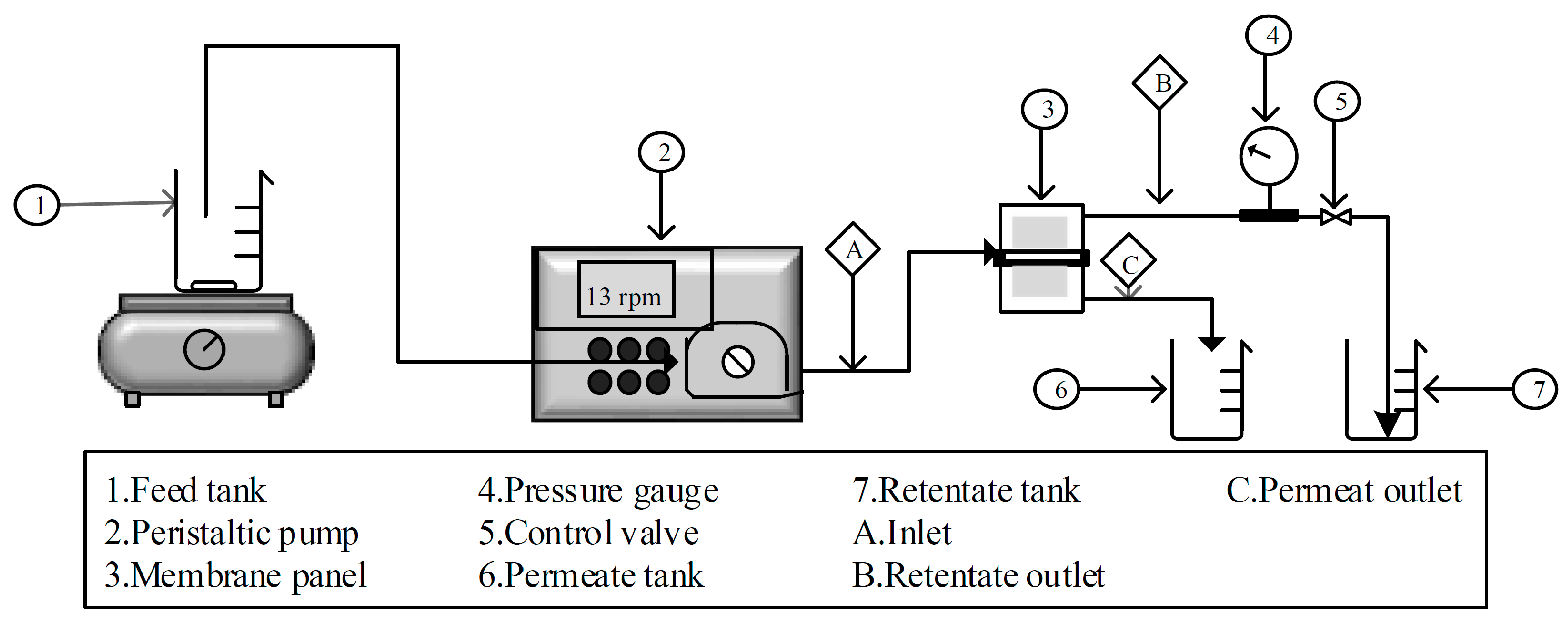
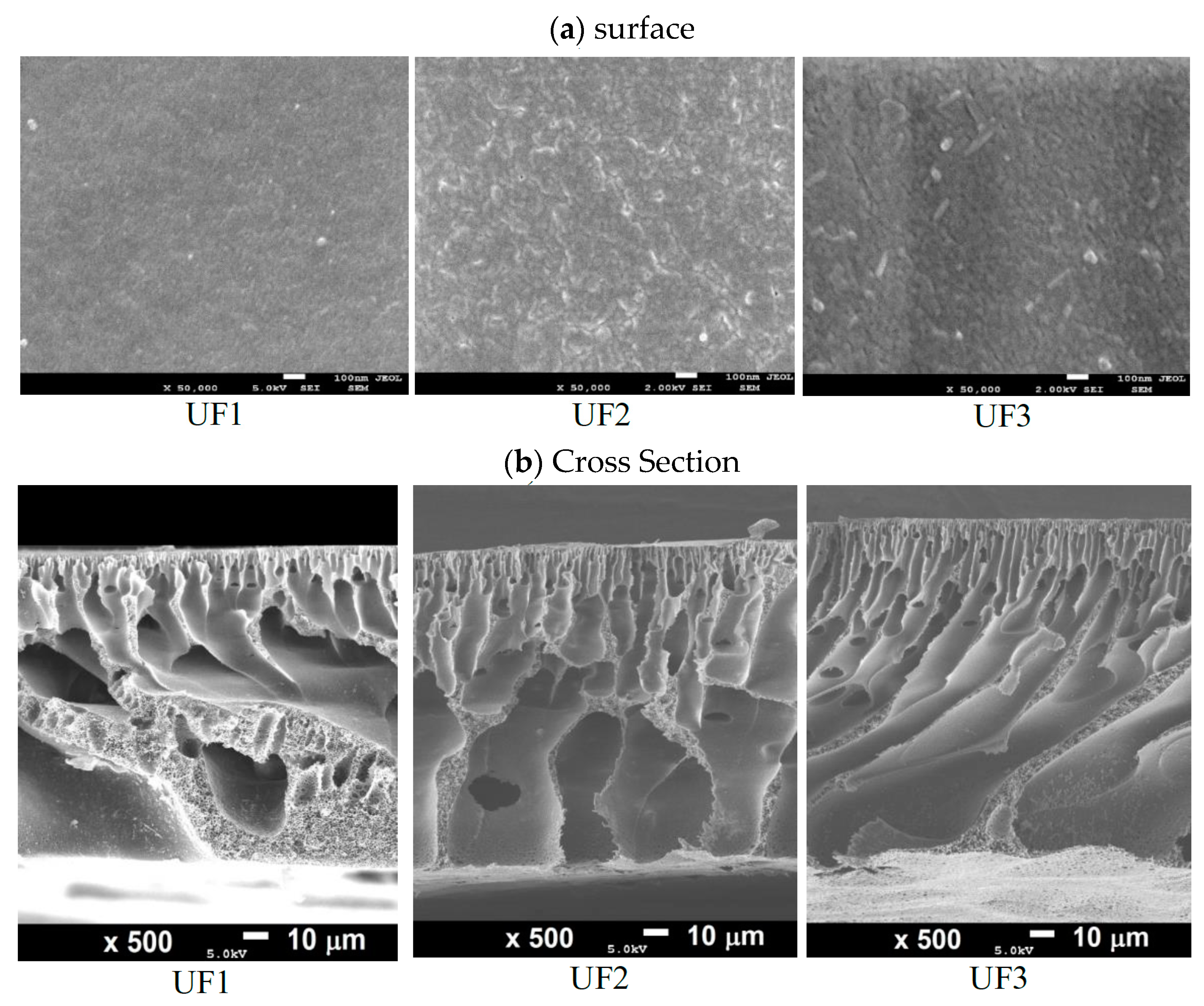

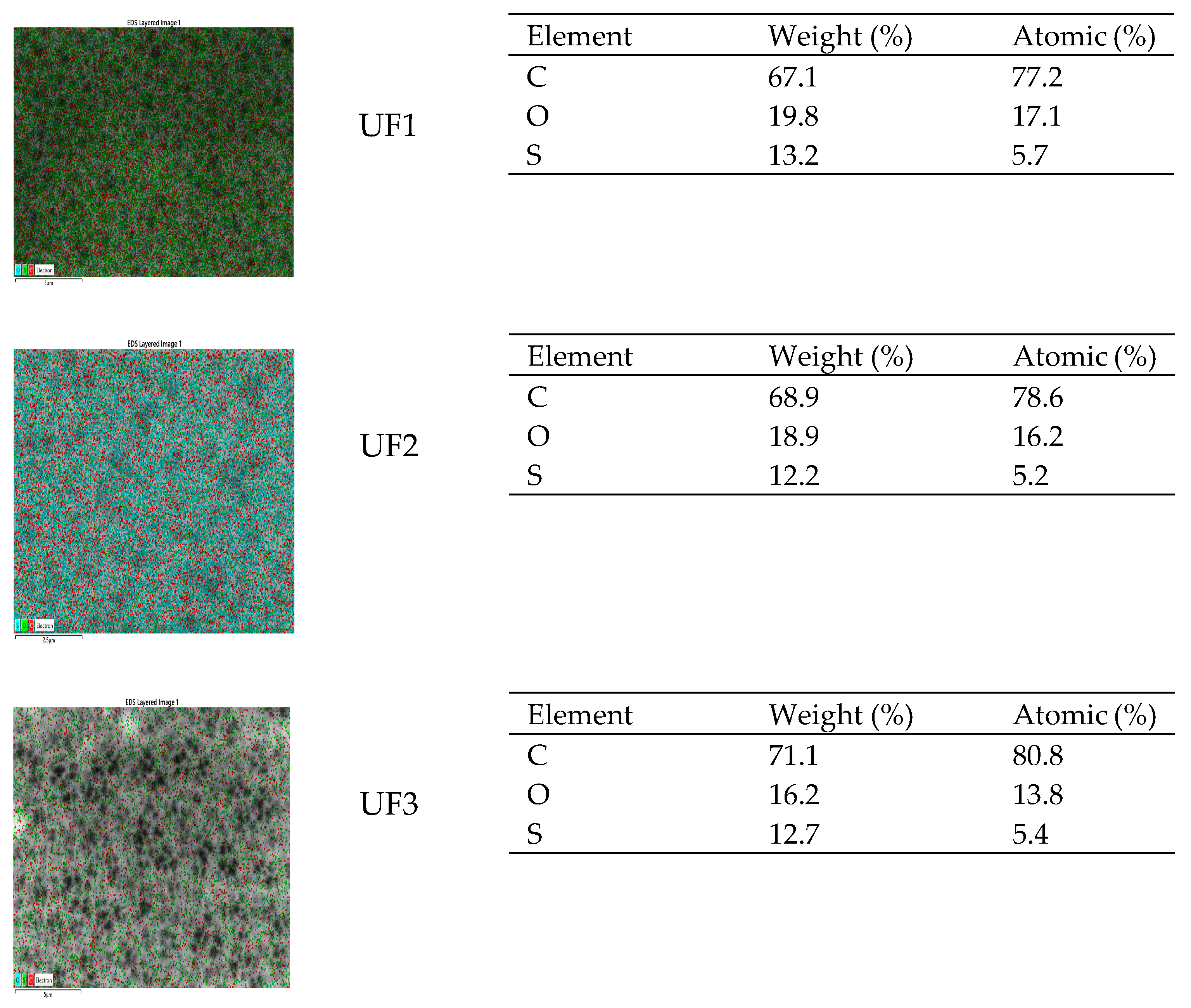

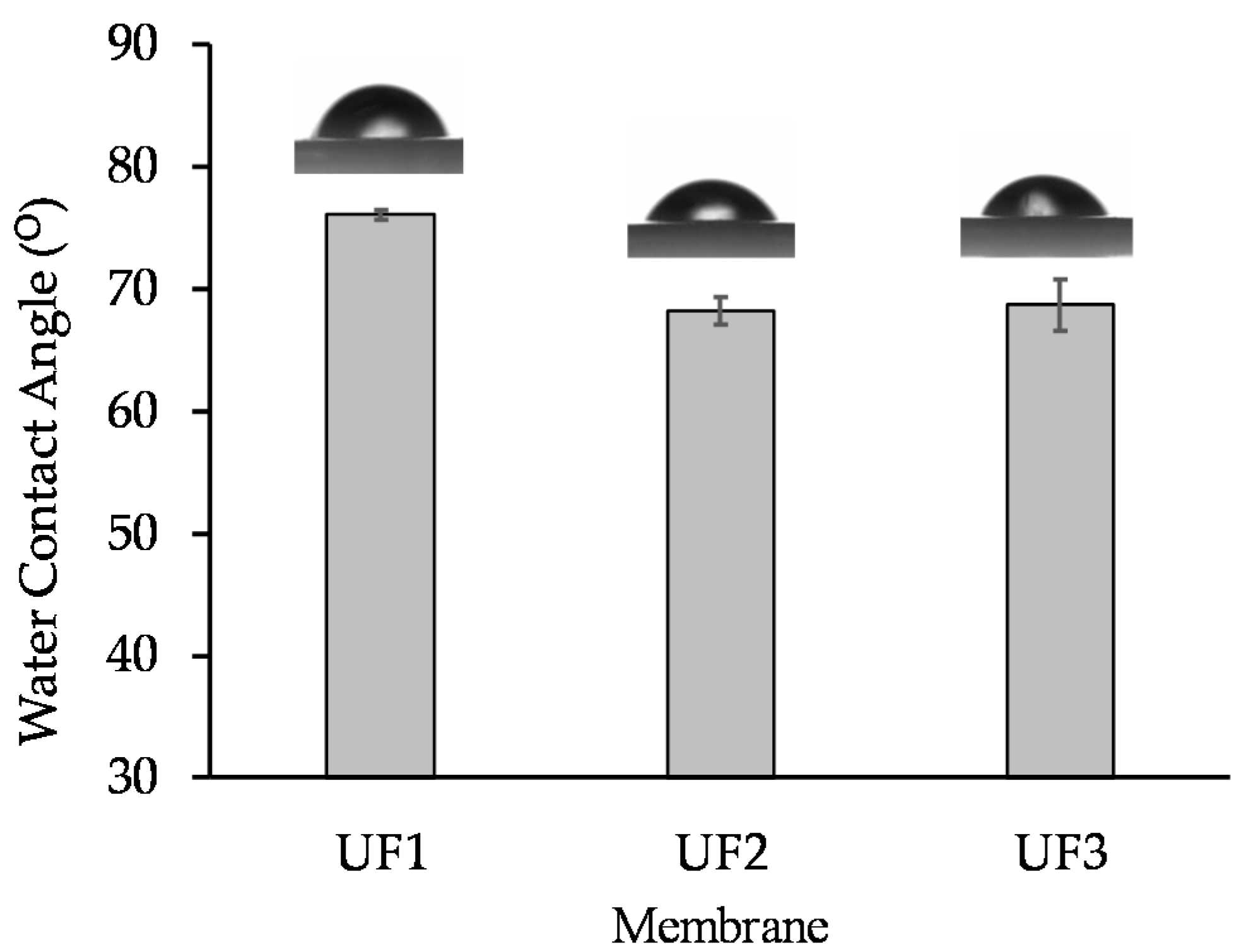
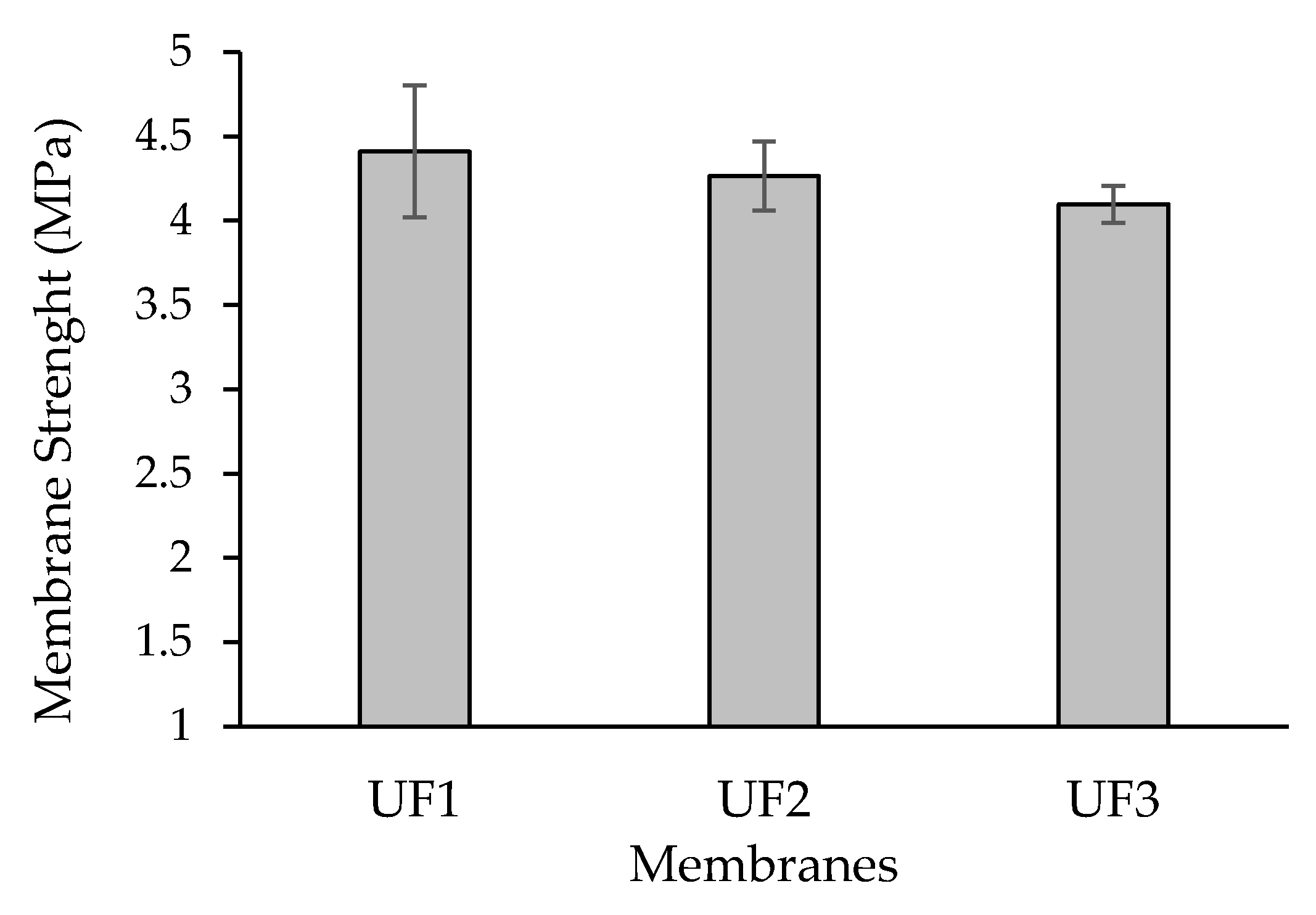
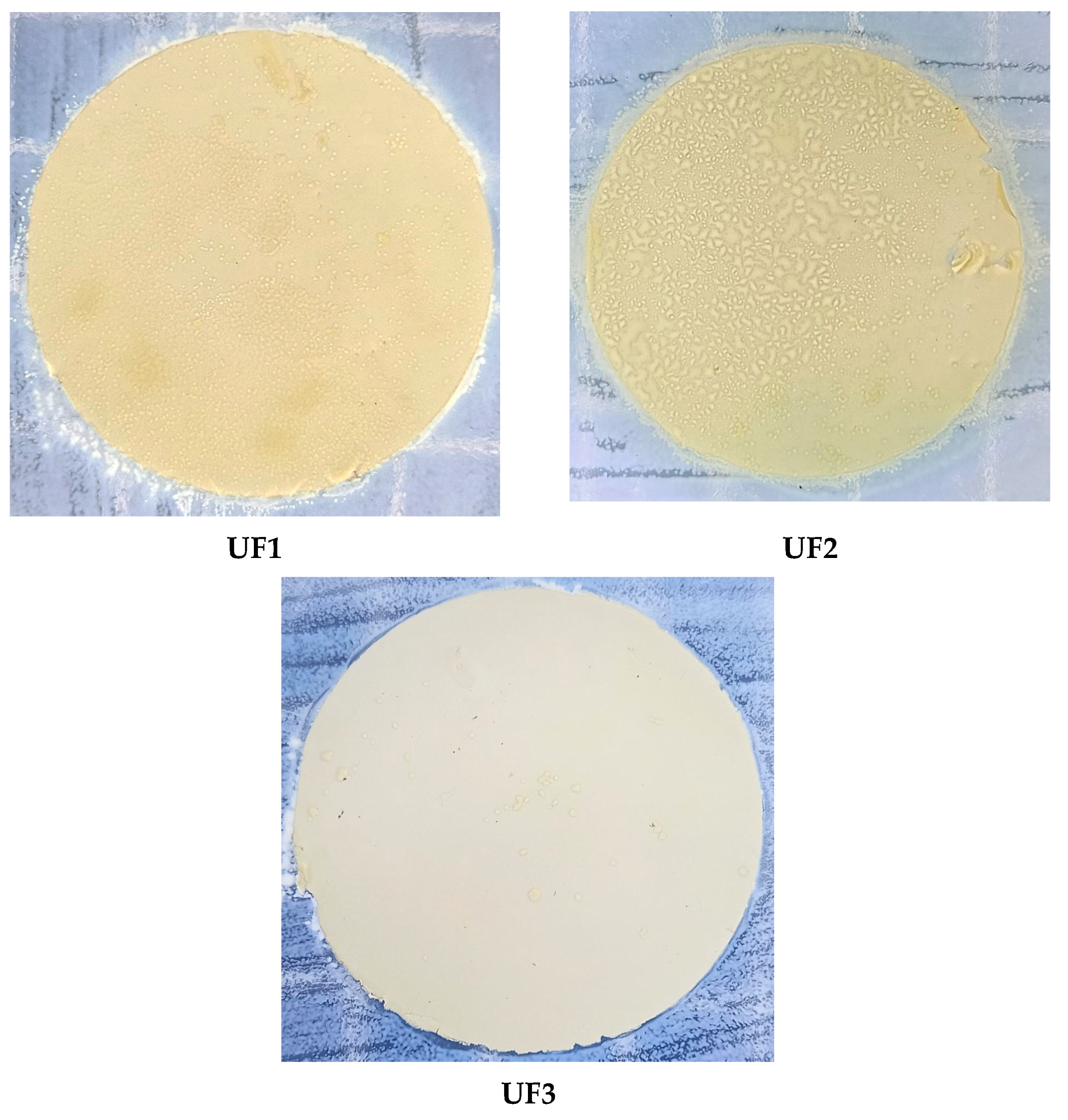
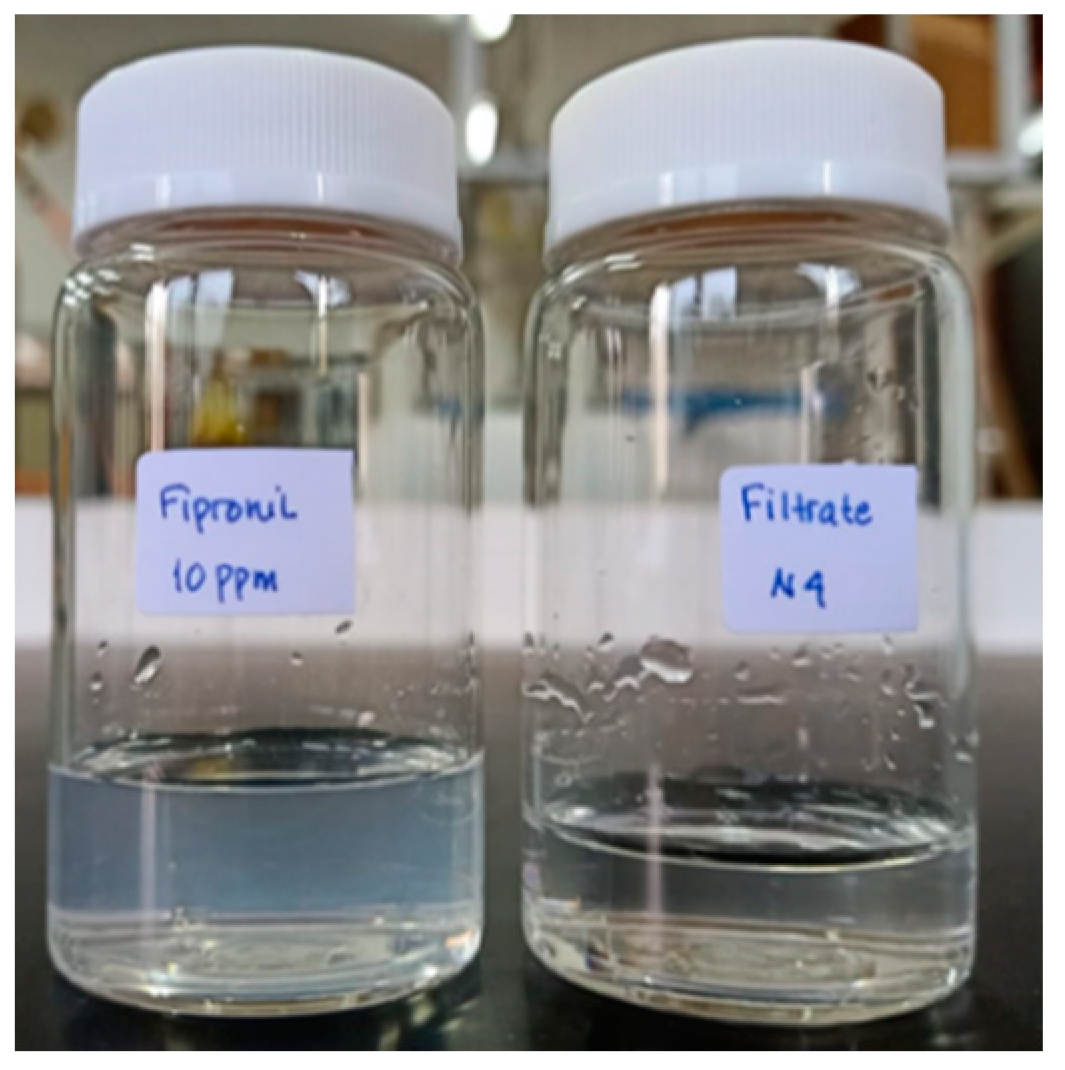
| Membrane Code | PES | Plu | PO | DMF |
|---|---|---|---|---|
| (wt %) | (wt %) | (wt %) | (wt %) | |
| UF1 | 15 | 0 | 0 | 85 |
| UF2 | 15 | 3 | 0 | 82 |
| UF3 | 15 | 3 | 3 | 79 |
| No | Membrane | Microbe Count | Unit |
|---|---|---|---|
| 1 | UF1 | 390 | Colony |
| 2 | UF2 | 360 | Colony |
| 3 | UF3 | 36 | Colony |
| Treatments Pair | Tukey HSD Q Statistic | Tukey HSD p-Value | Tukey HSD Inferfence | |
|---|---|---|---|---|
| Membranes (UF1;UF2;UF3) | Water Contact | 36.7491 | 0.0010053 | ** p < 0.01 |
| Tensile Strength | 5.4501 | 0.0182416 | * p < 0.05 | |
| Water Permeability | 25.9326 | 0.0010053 | ** p < 0.01 | |
| Fipronil Rejection | 36.2145 | 0.0010053 | ** p < 0.01 | |
| No | Membrane | Water Permeability (L/m2.hr.bar) | Fipronil Rejection (%) |
|---|---|---|---|
| 1 | UF1 | 72.23 | 85.20 |
| 2 | UF2 | 75.63 | 84.00 |
| 3 | UF3 | 85.87 | 75.50 |
Publisher’s Note: MDPI stays neutral with regard to jurisdictional claims in published maps and institutional affiliations. |
© 2021 by the authors. Licensee MDPI, Basel, Switzerland. This article is an open access article distributed under the terms and conditions of the Creative Commons Attribution (CC BY) license (https://creativecommons.org/licenses/by/4.0/).
Share and Cite
Arahman, N.; Rosnelly, C.M.; Windana, D.S.; Fahrina, A.; Silmina, S.; Maimun, T.; Mulyati, S.; Fathanah, U.; Aprilia, S.; Bilad, M.R.; et al. Antimicrobial Hydrophilic Membrane Formed by Incorporation of Polymeric Surfactant and Patchouli Oil. Polymers 2021, 13, 3872. https://doi.org/10.3390/polym13223872
Arahman N, Rosnelly CM, Windana DS, Fahrina A, Silmina S, Maimun T, Mulyati S, Fathanah U, Aprilia S, Bilad MR, et al. Antimicrobial Hydrophilic Membrane Formed by Incorporation of Polymeric Surfactant and Patchouli Oil. Polymers. 2021; 13(22):3872. https://doi.org/10.3390/polym13223872
Chicago/Turabian StyleArahman, Nasrul, Cut Meurah Rosnelly, Diki Sukma Windana, Afrillia Fahrina, Silmina Silmina, Teuku Maimun, Sri Mulyati, Umi Fathanah, Sri Aprilia, Muhammad Roil Bilad, and et al. 2021. "Antimicrobial Hydrophilic Membrane Formed by Incorporation of Polymeric Surfactant and Patchouli Oil" Polymers 13, no. 22: 3872. https://doi.org/10.3390/polym13223872
APA StyleArahman, N., Rosnelly, C. M., Windana, D. S., Fahrina, A., Silmina, S., Maimun, T., Mulyati, S., Fathanah, U., Aprilia, S., Bilad, M. R., Gunawan, P., Dzulhijjah, W. A., & Halimah, N. (2021). Antimicrobial Hydrophilic Membrane Formed by Incorporation of Polymeric Surfactant and Patchouli Oil. Polymers, 13(22), 3872. https://doi.org/10.3390/polym13223872











